Lec5w.MOSInspAnalysis.ee140.s11.ctn
lec评价法四级
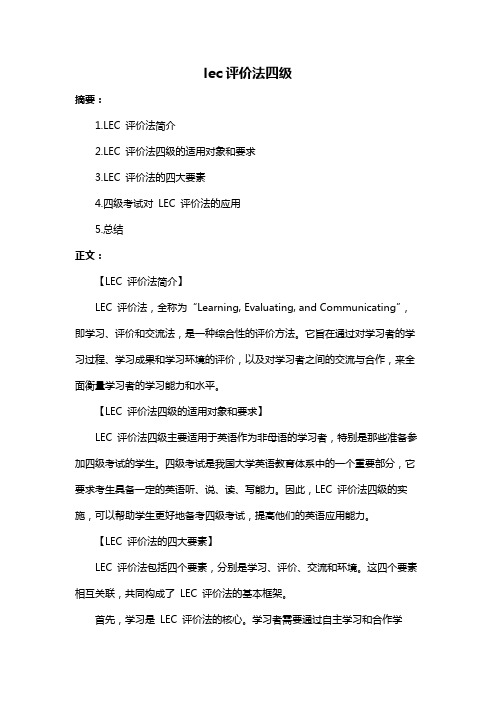
lec评价法四级摘要:1.LEC 评价法简介2.LEC 评价法四级的适用对象和要求3.LEC 评价法的四大要素4.四级考试对LEC 评价法的应用5.总结正文:【LEC 评价法简介】LEC 评价法,全称为“Learning, Evaluating, and Communicating”,即学习、评价和交流法,是一种综合性的评价方法。
它旨在通过对学习者的学习过程、学习成果和学习环境的评价,以及对学习者之间的交流与合作,来全面衡量学习者的学习能力和水平。
【LEC 评价法四级的适用对象和要求】LEC 评价法四级主要适用于英语作为非母语的学习者,特别是那些准备参加四级考试的学生。
四级考试是我国大学英语教育体系中的一个重要部分,它要求考生具备一定的英语听、说、读、写能力。
因此,LEC 评价法四级的实施,可以帮助学生更好地备考四级考试,提高他们的英语应用能力。
【LEC 评价法的四大要素】LEC 评价法包括四个要素,分别是学习、评价、交流和环境。
这四个要素相互关联,共同构成了LEC 评价法的基本框架。
首先,学习是LEC 评价法的核心。
学习者需要通过自主学习和合作学习,来提高自己的语言能力。
其次,评价是LEC 评价法的重要组成部分。
它通过对学习者的学习成果和学习过程进行评价,来衡量学习者的学习能力。
再次,交流是LEC 评价法的另一个重要要素。
它强调学习者之间的交流与合作,以此来提高学习者的语言应用能力。
最后,环境是LEC 评价法的另一个重要组成部分。
它要求学习者在一个良好的学习环境中进行学习,以此来提高学习者的学习效率。
【四级考试对LEC 评价法的应用】四级考试对LEC 评价法的应用,主要体现在以下几个方面。
首先,四级考试要求学习者具备一定的听、说、读、写能力,这正是LEC 评价法所强调的。
其次,四级考试的评分标准也与LEC 评价法相似。
它不仅注重学习者的语言知识,还注重学习者的语言应用能力。
最后,四级考试也鼓励学习者之间的交流与合作,这与LEC 评价法的理念是一致的。
电子吸气酌酒器说明书

AlcolockThe alcolock is a factory-mounted electronic breath alcohol analyser, designed to reduce alcohol-related accidents. The alcolock consists of a stationary unit inside the instrument panel and a hand-held unit with cable. The electric drive unit can be started without a breath test, but to be able to release the parking brake and drive off with the truck, the driver is re-quired to pass a breath test.Activation is done in two different ways: by pressing the right-hand side button on the alcolock unit or by turning the truck on and then off with the starter key.When turning on the alcolock unit the LCD display says “Wait”, followed by “Blow for 5 seconds”. The driver then ex-hales for five seconds through a mouthpiece (one per user) on the handheld unit. If the breath test is accepted, “Start Motor”is shown in the display. If the alcohol level is over the set limit,“Lock Out” will be displayed and the parking brake cannot be released. A new breath test can be done one minute after the previous test.When passing the test successfully, the driver has five min-utes to start the electric drive unit, release the parking brake and drive off. If the electric drive unit has been switched off forless than 30 minutes, no new breath test is required.Volvoʼs alcolock measures the alcohol content very accu-rately, but the content can be affected by external conditions.An approved breath test is not a full guarantee for an alcohol content below the tolerance level and will not give any legal protection against driving under the influence. The service and calibration interval for the alcolock unit is 12 months.Mouthpieces are available to purchase in packages of 25pieces.The alcolock manual and the hand unit menus are in the same language as the Driver Guide.SPECIFICATIONType.........................................................................................Alcolock V3Hand unit size.............................................................150 x 46 x 50 mm Hand unit weight.............................................................................400 g Sensor............................................................Electro-chemical (fuel cell)Analysis time...............................................................................5 to 25 s Range of measurement............................................0.00 to 2.50 mg/L Accuracy...................................................................±0.02 at 0.20 mg/L Max. alcohol tolerance level...................................................0.20 mg/L Display......................................................................Graphic LCD display Voltage..........................................................................................24 V DC Standby power..........................................................................< 20 mAh Ambient temperature........................................................-45 to +80 °CVolvo Trucks. Driving Progress2022-05-02 ENG Version 01 1 (1)Volvo retains the right to modify design and specifications without prior notification.FACT SHEETAlcolockPCE4。
Effects of Audit Quality on Earnings Management and Cost of Equity Capital Evidence from China

constrains managerial reporting discretion and therefore reduces information risk. We measure managerial reporting discretion and information risk by the magnitude of discretionary accruals and use it to assess the effect of audit quality (Becker et al. 1998). We also utilize the ex ante cost of equity capital as a yardstick to assess the valuation implications of audit quality, as do Khurana and Raman (2004). If high audit quality reduces information risk, which is non-diversifiable, it should translate to a tangible benefit in the form of lower cost of equity capital. Our analyses are based on a sample of 3,310 firm-year observations with sufficient data on the China Securities Markets and Accounting Research Database from 2001 to 2004. Consistent with prior research, we use audit firm size as a proxy for audit quality. We classify the eight largest audit firms (Top 8), which include the international Big 4 and the four largest Chinese firms, as high audit quality providers and all other audit firms (non-Top 8) as low audit quality providers. We use absolute and signed performance-matched modified Jones model discretionary accruals to measure earnings management. We measure ex ante cost of equity capital using the industry method introduced by Gebhardt, Lee, and Swaminathan (2001) and the PEG ratio method proposed by Easton (2004). We find a significantly lower level of earnings management for NSOEs audited by Top 8 auditors than for NSOEs audited by non-Top 8 auditors. In contrast, we do not observe a significant corresponding difference in the level of earnings management for SOEs. Additionally, we find a significantly greater reduction in earnings management from hiring Top 8 versus non-Top 8 auditors for NSOEs than for SOEs. We obtain consistent results when we use absolute discretionary accruals and income-increasing discretionary accruals to measure earnings management. Our analysis indicates that the effect of audit quality on cost of equity capital is not uniform across SOEs and NSOEs. Cost of equity capital is significantly lower for NSOEs audited by Top 8 auditors than for NSOEs audited by non-Top 8 auditors, but not
lec判别法

lec判别法
(实用版)
目录
1.Lec 判别法简介
2.Lec 判别法的基本原理
3.Lec 判别法的应用领域
4.Lec 判别法的优缺点
正文
Lec 判别法,全称 Lecun 支持向量机判别法,是一种基于支持向量机(SVM)的机器学习算法,主要用于图像分类和数据挖掘领域。
Lec 判别法以其较高的准确性和较强的泛化能力,在众多分类算法中脱颖而出,成为当前应用最为广泛的分类方法之一。
Lec 判别法的基本原理是基于最大间隔分类的思想,通过找到一个最优的超平面,将不同类别的数据分隔开来。
在训练过程中,Lec 判别法使用核函数将原始数据映射到高维空间,从而提高分类的准确性。
此外,Lec 判别法还采用了正则化技术,以防止过拟合现象的发生。
Lec 判别法的应用领域非常广泛,包括计算机视觉、语音识别、文本分类、生物信息学等。
特别是在图像分类领域,Lec 判别法凭借其优越的性能,成为了许多图像识别任务的首选算法。
Lec 判别法具有许多优点,例如较高的分类准确性、较强的泛化能力和较好的鲁棒性。
然而,它也存在一些缺点,如计算复杂度较高、对噪声敏感以及需要选择合适的核函数等。
为了克服这些缺点,研究者们在 Lec 判别法的基础上,提出了许多改进算法,如多项式核、径向基核、支持向量回归等。
总之,Lec 判别法作为一种经典的机器学习算法,在许多应用领域都
取得了显著的成果。
ICP-MS法测定富硒灵芝中22种微量元素的含量

分析检测ICP-MS法测定富硒灵芝中22种微量元素的含量卢任杰1,罗 琳1,韩 飞2(1.汕头市检验检测中心,广东汕头 515041;2.汕头职业技术学院,广东汕头 515078)摘 要:采用硝酸处理富硒灵芝,经微波消解后,以在线内标法利用电感耦合等离子体质谱测定富硒灵芝中22种元素含量。
结果表明,22种元素在0.5~100.0 μg·L-1,线性回归方程的相关系数大于0.999 5,定量限为0.080~1.600 µg·kg-1,回收率为89.6%~111.5%,相对标准偏差为0.7%~5.3%。
关键词:富硒;灵芝;电感耦合等离子体质谱(ICP-MS);微量元素Determination of 22 Trace Elements in Se-enriched Ganodermalucidum by ICP-MSLU Renjie1, LUO Lin1, HAN Fei2(1.Shantou Inspection and Testing Center, Shantou 515041, China; 2.Shantou Polytechnic, Shantou 515078, China)Abstract: Se-enriched Ganoderma Lucidum was treated with nitric acid and digested by microwave. The content of 22 elements in Se-enriched Ganoderma Lucidum was determined by inductively coupled plasma mass spectrometry (ICP-MS) with online internal standard method. The results show that 22 elements range from 0.5 to 100.0 μg·L-1, the correlation coefficient of the linear regression equation is greater than 0.999 5, and the quantification limit is 0.080~1.600 µg·kg-1; The recovery rate is 89.6%~111.5%, and the relative standard deviation is 0.7%~5.3%.Keywords: selenium rich; Ganoderma lucidum; inductively coupled plasma mass spectrometry (ICP-MS); trace element灵芝(Ganoderma lucidum)是中国有数千年历史的传统名贵药材,具有调节免疫系统、抗肿瘤、防衰老、止咳平喘等药效[1-2]。
001 (ISSCC tutorial)Noise Analysis in Switched-Capacitor Circuits

© 2011 IEEE
IEEE International Solid-State Circuits Conference
© 2011 IEEE
Thermal Noise Power
• Nyquist showed that
PSD ( f ) = 4kT
• The total average noise power of a resistor in a certain frequency band is therefore
– Examples: Audio systems, wireless transceivers, sensor interfaces
• Electronic noise directly trades with power dissipation and speed • Electronic noise is a major concern in modern technologies with reduced VDD
• The noise of a MOSFET operating in the triode region is approximately equal to that of a resistor • In the saturation region, the thermal noise can be modeled using a drain current source with power spectral density
• We can model the noise using an equivalent voltage or current generator
2 vn
= Pn ⋅ R = 4kT ⋅ R ⋅ Δf
美国LECO碳硫测定仪系统分析及故障处理

二〇〇八年・第二期使用与维修美国LE C O碳硫测定仪系统分析及故障处理梁敏钅监 戴学谦 张瑞霖 廉晓洁 薛江红(太原钢铁公司技术中心 太原 030003)摘 要 本文系统地对CS600碳硫测定仪的电路和气路控制系统原理进行分析,并给出维修实例。
关键词 碳硫测定仪 电子控制 气路前言美国LECO生产的CS600分析仪是目前我国在冶金分析行业中使用的红外碳硫分析仪中的主要机型。
本文把作者在工作遇到的问题及解决办法写出,希望对同行在遇到类似问题时有些帮助。
1 碳硫测定仪电子控制组成与气路系统原理碳硫测定仪的电子控制部分由红外测量控制板、分析气流控制板、动力气流控制板、功率控制板、恒温箱加热控制板、压力控制板、催化温度控制板及计算机和其它电子元件组成。
载气在分析气路中的流程:氧气通过入口的稀土氧化铜去除载气中的一氧化碳、甲烷等杂质,流经碱石棉和过氯酸镁去除二氧化碳和水后,通过吹氧枪和载气入口进入炉头。
试样在燃烧管内燃烧后生成的气体随载气经过氯酸镁去除其中的水汽后,进入硫检测池,之后流经镀铂硅胶及赛璐璐,将载气中的二氧化硫转化为三氧化硫并去除。
载气中的二氧化碳在仪器气路后端的高碳和低碳检测池中测定。
2 碳硫分析仪电子控制与气路的检修211 碳硫分析仪电子控制部分的检修通过执行CS600诊断菜单中的网络状态观察功能即可看到每块控制板的在线状态。
每块控制板由控制板主板及插接在上面的通信板组成。
当网络状态显示控制板为灰色时,控制板工作不正常。
这时可以采取关机重启,或重新拔插US B连线的方式进行检查。
如果不能重新连接,应更换US B连线或通信板。
但是,当网络状态显示控制板为正常工作的黑色状态时,也会出现通信板正常而主控板损坏的情况,这时需要结合仪器工作的表现进行判定。
图1 碳硫分析仪的气路16现代仪器(www1m o de rn i n s trs1o rg1cn)二〇〇八年・第二期这时仪器的状态应是网络状态显示正常,而控制板的控制功能却处于失控状态,出现这种情况应及时停机更换新控制板。
日式品牌的电子静电模拟仪器产品说明书

1w w w.n o i s e k e n.c o mThe electrostatic simulator you always use is renewed now. The new main unit and discharge gun in sale now are `ESS-S3011A`, ` ESS-B3011A` and `GT-30RA`.For repair maintenance in our company, we discontinue repair support 8 years after delivery according to warranty and 5 years after sales termination. For those electrostatic simulators whose repair support is terminated, we may decline to repair. For discharge gun 'TC-815 series', as there are many discontinued parts, it is difficult to continue to support it. We plan to terminate the repair support as the following schedule.ESD SimulatorESS-S3011A & GT-30RASmart model equipped high function & extendibilityInformation on successive model (current model)Repair support termination schedule:discharge gunModelRepair service and support statussuccessive modelTC-815C terminated GT-30RA TC-815D terminated GT-30RA TC-815D(F)terminated GT-30RA TC-815P terminated GT-30RA TC-815R terminatedGT-30RA TC-815RE22020年(scheduled)GT-30RA TC-815S2020年(scheduled)GT-30RA TC-815-330/2K2020年(scheduled)GT-30R3302KA※Old standard:IEC61000-4-2 Ed1 compliant (new standard incompliant)Repair support termination schedule noticeModelRepair service and support status successive modelESS-630 series terminated ESS-B3011A ESS-200AX terminated ESS-S3011A ESS-100L terminated ESS-B3011A ESS-100LA terminated ESS-B3011A ESS-2000terminated ESS-S3011A ESS-2002terminated ESS-B3011A ESS-2000AX terminated ESS-S3011A ESS-2002EXterminatedESS-B3011AFor the customers who above have electrostatic simulators and discharge gun, please consider to buy the successive model(current model) as replacement.ESS-630A ESS-200AX ESS-100L ESS-2000ESS-2002ESS-2000AX/2002EXEMC test equipment to evaluate the resistibility of electronic equipments when en-ergy charged on a human body or object is discharged to the electronic equipment.This can be available for evaluating malfunctions or functions declines of electronic equipment against the ESD.Programmable simulator to ease some complicated tests. The output voltage is up to 30kV and performable IEC61000-4-2 & ISO 10605 Standardscompliant tests.●“3 pre-checking function” to make sure the more confirmable test ●“CR constant indicator” to make sure the correct unit attachment ●One-touch exchange of gun head and CR unit realized ●“Ten-key & Rotary knob” to ease the setting.●“Discharge Detecting Function” to realize the air-discharge confirmation.●“Lightest discharge gun in the market” to lighten the continuous operation (Excluding the cable and connector)●“White LED Irradiator” to facilitate the visualization of the discharging areas.●“ Control Software” to enable the test result reporting and control with PC.Provided by:Advanced Test Equipment Corp .® (800) 404-ATECRentals • Sales • Calibration • ServiceESD SimulatorESS-B3011A & GT-30RACost-oriented basic model ESD Simulator the light weight discharge gun attach-able.The output voltage can be selected either max. 30kV (B3011A) or max.16kV (L1611A) and compliant to both EN/IEC61000-4-2 Standard (both B3011A and L1611A) and ISO10605 Standard (only B3011A).Cost-oriented Basic modelsESS-S3011A & GT-30RAParameter Specification Polarity Positive / Negative Output voltage 0.20kV ~ 30.0kV±5% (30.5kVmax) ~10.0kV : 0.01kV step ~30.0kV : 0.1kV step Repetition cycle 0.05s ~ 600s±10% / Manual Set step : 0.01s (0.05 ~ 9.99s), 0.10s (10.0 ~ 600.0s)No. of time of discharge 1~60,000 times, Preset 1 time step or continuous preset Discharge mode Contact discharge / Air discharge Radiation level mode NORMAL mode / EXTRA mode Trigger mode Gun trigger / Main trigger / External trigger Operation panel Color LCD / Push-buttons (Partially lighting)Gun holder Standard attached (to hold the discharge gun Model GT-30RA)Radiation mode select switch Extra / Normal switching function built-inDischarge detection Discharge detection function in air-discharge equipped Pre-checking function Following 3 steps function equipped (by user operation. Not the calibration but just checking) SETP1 : High voltage output checking STEP2 : Withstanding voltage checking STEP3 : Discharge relay operation checking CR & Gun head checking CR constant and gun head recognizable (with an indicator to prevent the wrong combination)Parameter Specification"IEC STANDARD" Contact discharge mode : 2.0kV, 4.0kV, 6.0kV and 8.0kV step test mode Air discharge mode : 2.0kV, 4.0kV, 8.0kV and 15.0kV step "MANUAL" Contact / Air discharge mode, Arbitrary setting during 0.2kV~30.0kV test mode Sweeping function built-in, Recordable up to 99 units "SEQUENCE" Enables to operate units set in MANUAL mode continuously.test mode Max. 22 steps / 1 program and the programs recordable up to 20.Warning lamp Lighting at voltage output from the generator. Blinking at electro-static dischargingCharge capacitor / resistor 150pF±10%, 330Ω±10%(Built-in CR unit for discharge gun GT-30RA)Charge resistor in generator 10MΩ(Totally 53Ω in combination with 43MΩ in discharge gun)*AUX connector D-SUB 15pins female connector (for connecting to patolight, automated ESD eliminator, external interlock input, external trigger input terminal)Optical communication Optical connector (serial interface) for connecting to PC connector Power supply / consumption AC100V~AC240V 50Hz / 60Hz ±10% 75VA Dimension Generator : (W)392mm X (H)312mm X (D)295.3mm (including gun holder) Discharge gun : (W)83.3mm X (H)217.2mm X (D)229.3mm Mass Generator : Approx. 7.5kg Discharge gun : Approx. 800g (excluding cable and connector)* The constant depends on combination with CR unit for the discharge gun● “Pre-checking function” taking the confirmable test into the account ● “Discharge Detecting Function” to realize the air-discharge confirmation.● “Lightest Discharge Gun in the market” to lighten the continual operation"● “White LED Irradiator” to facilitate the visualization of the discharging area.● “CR constant checking function” (No indicator) to make the correct unit attachment sure"● One-touch exchange of gun head and CR unit realizedParameter Specification Output voltage 0.20kV~30.0kV±5%(30.5kVmax) ESS-L1611A is 16kVmax Polarity Positive / Negative Repetition cycle 0.05s~9.99s±10%, 0.01s step / ManualNo. of time of discharge 1~999 times, Preset 1 time step or continuous preset Discharge mode Contact discharge / Air discharge Trigger mode Gun trigger / Main trigger Operation panel Indicator : 5X7 Dot matrix LED / Operation : Push buttons Radiation mode select switch Extra / Normal switching function built-inDischarge detection Discharge detection function in air-discharge equipped.Pre-checking function High voltage output checking function (by user operation. Not the calibration but just checking)CR & Gun head CR constant and gun head recognizable checking (to prevent the wrong combination without indicator)IEC LEVELContact discharge mode : 2.0kV, 4.0kV, 6.0kV and 8.0kV step Switching function Air discharge mode : 2.0kV, 4.0kV, 8.0kV and 15.0kV step)Parameter SpecificationWarning lamp Lighting at voltage output from the generator. Blinking at electro-static discharging Charge capacitor / resistor 150pF±10%, 330Ω±10% (Built-in CR unit for discharge gun GT-30RA)Charge resistor in generator 10MΩ (Totally 53Ω in combination with 43MΩ in discharge gun)*Power supply / consumption AC100V~AC240V ±10% 50Hz / 60Hz 62VA Dimension Generator : (W)270 X (H)263 X (D)200mm Discharge gun : (W)83.3 X (H)217.2 X (D)229.3mm Mass Generator : Approx. 4.8kg Discharge gun : Approx. 800g (excluding cable and connector)* Remote control function not built-in.* The constant depends on combination with CR unit for the discharge gun。
SPE124415-译文
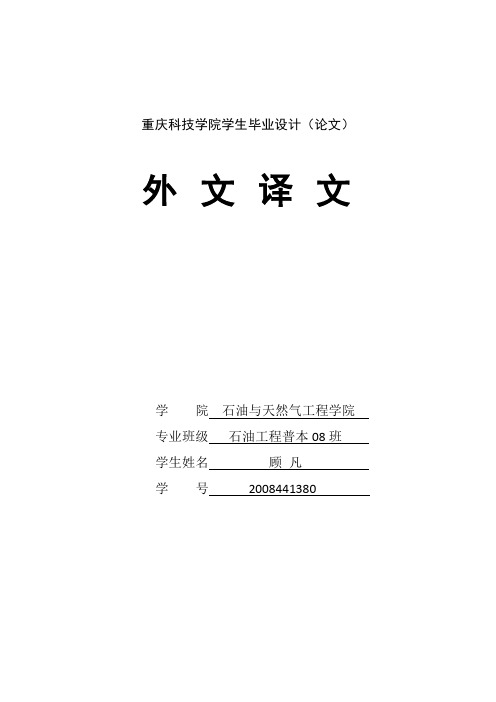
重庆科技学院学生毕业设计(论文)外文译文学院石油与天然气工程学院专业班级石油工程普本08班学生姓名顾凡学号2008441380译文要求1.外文翻译必须使用签字笔,手工工整书写,或用A4纸打印。
2.所选的原文不少于10000印刷字符,其内容必须与课题或专业方向紧密相关,由指导教师提供,并注明详细出处。
3.外文翻译书文本后附原文(或复印件)。
SPE124415异常高压型气藏应力敏感性的动态特征评估方法摘要目前全世界范围内都遇到了异常高压气藏的问题。
由于不寻常的压力环境,应力敏感渗透是对于储集性能的一个潜在影响。
如果我们用传统的试井分析软件解释敏感数据,表皮系数的结果将会异常积极。
对试井测试和性能预测的解释是一项重大的挑战。
本文通过考虑到应力敏感渗透的有限元法建立了数值试井模型并开发了模拟器,得到了对数曲线并对它们的特点进行了分析。
在早期,敏感储层与普通储层的压力反应是一致的,在后期,压力储层达到半对数直线,但衍生曲线值小于0.5。
过渡期被敏感渗透控制,而对于低敏感渗透性模块来说过渡期较长。
在对数图中,压力和压力导数之间的距离大于正常储层。
通过log—log分析可以得到渗透率模数。
对天然气产能应力敏感性的影响的评估方法是通过使用渗透率模数的概念提出的。
通过将LIT方程式与物质平衡方程式相结合,性能预测模型也被建立。
气藏的物质平衡方程的已经考虑到地层的有效压缩性。
本文在经过塔里木盆地异常应力敏感气藏流测试后提出了一种流量分析。
通过数值模拟分析基于试井测试反应的应力敏感渗透率的影响。
渗透率模数约0.01MPa;表皮系数是1.48(传统的软件是60.8; 无阻流量减少量为14%;稳定生产期下降5.5;储备恢复下降的程度是6.8%)。
解释结果表明,数值试井分析可以准确地识别油气储层参数和酸化的有效性,而且气体的供应能力是不同的并取决于天然气井所在的地层的渗透率模数。
导言拥有不正常高压的气藏已经在全世界被发现。
LEC危险性

危险性(LEC)评估法 LEC , 危险性, 评估1)LEC 法,主要是以系统危险有关的三种因素指标值之积来评价系统人员伤亡危险的大小。
三种因素是:L ——发生事故的可能性大小,L 值定为0.1—10,如表1 E ——人体暴露于危险的频繁程度,E 值定为0.5—10,如表2 C ——发生事故可能造成的后果,C 值定为1—100,如表3 评价公式是:D=LEC其中D —危险性分值,根据经验,总分在40分以下为可承受风险,总分在320分以上是高危险分值,1—2级需要严格监控,并制定方案或目标进行控制,3—4级需要加强监控,对运行进行控制。
分级如附表4所示收藏 分享全场商品免邮费,欢迎在线选购安全月宣传品四哥笑谈人生昵称: 四哥谈安全头衔: 安全专家 安全人博客帖子 37102#发表于 2010-10-18 19:24 | 只看该作者表1发生事故的可能性(L )表2暴露于危险环境的频繁程度(E )精华1 积分 8574 注册时间2010-9-24TOP四哥笑谈人生昵称: 四哥谈安全 头衔: 安全专家 安全人博客3#帖子 3710 精华1 积分 8574 注册时间2010-9-24表3表3发生事故产生的后果(C )表4危险分值(D )关注安全人博客---共建安全人的家TOP四哥笑谈人生昵称: 四哥谈安全 头衔: 安全专家安全人博客帖子 3710 精华1 积分 8574 注册时间2010-9-244#发表于 2010-10-18 19:25 | 只看该作者说明:40—70:一般危险,需要注意70—160:显著危险,需要整改160—320:高度危险,立即整改 320以上:极其危险,不能继续作业。
LEC风险评价法
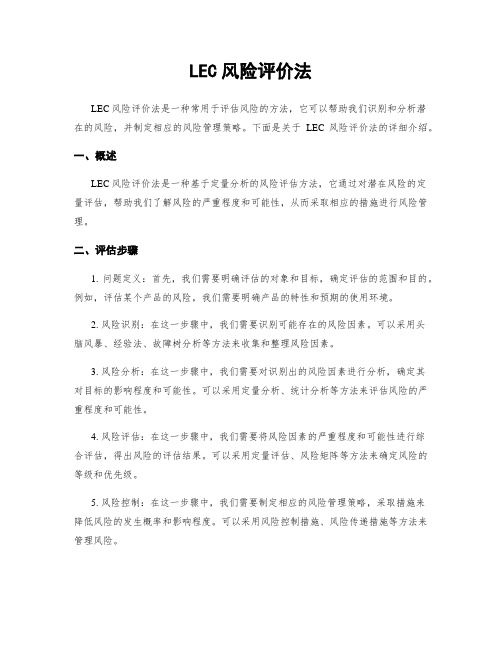
LEC风险评价法LEC风险评价法是一种常用于评估风险的方法,它可以帮助我们识别和分析潜在的风险,并制定相应的风险管理策略。
下面是关于LEC风险评价法的详细介绍。
一、概述LEC风险评价法是一种基于定量分析的风险评估方法,它通过对潜在风险的定量评估,帮助我们了解风险的严重程度和可能性,从而采取相应的措施进行风险管理。
二、评估步骤1. 问题定义:首先,我们需要明确评估的对象和目标,确定评估的范围和目的。
例如,评估某个产品的风险,我们需要明确产品的特性和预期的使用环境。
2. 风险识别:在这一步骤中,我们需要识别可能存在的风险因素。
可以采用头脑风暴、经验法、故障树分析等方法来收集和整理风险因素。
3. 风险分析:在这一步骤中,我们需要对识别出的风险因素进行分析,确定其对目标的影响程度和可能性。
可以采用定量分析、统计分析等方法来评估风险的严重程度和可能性。
4. 风险评估:在这一步骤中,我们需要将风险因素的严重程度和可能性进行综合评估,得出风险的评估结果。
可以采用定量评估、风险矩阵等方法来确定风险的等级和优先级。
5. 风险控制:在这一步骤中,我们需要制定相应的风险管理策略,采取措施来降低风险的发生概率和影响程度。
可以采用风险控制措施、风险传递措施等方法来管理风险。
6. 风险监控:在这一步骤中,我们需要定期对已实施的风险管理策略进行监控和评估,确保其有效性和及时性。
可以采用风险指标、风险报告等方法来监控风险的变化和控制效果。
三、案例分析以某公司生产的电子产品为例,使用LEC风险评价法进行风险评估。
1. 问题定义:评估该电子产品的潜在风险,以确保产品的安全性和可靠性。
2. 风险识别:通过调研和专家访谈,识别出可能存在的风险因素,如电路设计不合理、元器件质量问题、生产工艺不稳定等。
3. 风险分析:对识别出的风险因素进行分析,评估其对产品的影响程度和可能性。
例如,电路设计不合理可能导致产品故障率增加,元器件质量问题可能导致产品寿命缩短。
cs elemental analysis method
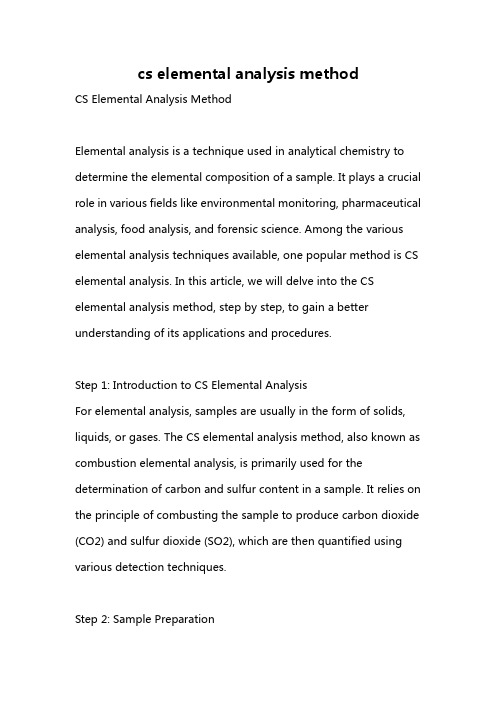
cs elemental analysis methodCS Elemental Analysis MethodElemental analysis is a technique used in analytical chemistry to determine the elemental composition of a sample. It plays a crucial role in various fields like environmental monitoring, pharmaceutical analysis, food analysis, and forensic science. Among the various elemental analysis techniques available, one popular method is CS elemental analysis. In this article, we will delve into the CS elemental analysis method, step by step, to gain a better understanding of its applications and procedures.Step 1: Introduction to CS Elemental AnalysisFor elemental analysis, samples are usually in the form of solids, liquids, or gases. The CS elemental analysis method, also known as combustion elemental analysis, is primarily used for the determination of carbon and sulfur content in a sample. It relies on the principle of combusting the sample to produce carbon dioxide (CO2) and sulfur dioxide (SO2), which are then quantified using various detection techniques.Step 2: Sample PreparationBefore initiating the CS elemental analysis procedure, the sample must be appropriately prepared. Solids and liquids generally require drying to remove any moisture content that may affect the accuracy of the analysis. In some cases, samples are ground or homogenized to ensure uniformity. Gaseous samples, on the other hand, are directly introduced into the analysis system without any significant preparation steps.Step 3: CombustionThe critical step in CS elemental analysis is the combustion of the sample. It involves the controlled oxidation of the sample at a high temperature in the presence of excess oxygen. This process converts the carbon and sulfur in the sample into carbon dioxide and sulfur dioxide, respectively.Step 4: Separation and QuantificationAfter combustion, the carbon dioxide and sulfur dioxide gases are separated from the combustion gases using various techniques such as gas chromatography or thermal conductivity. The separated gases then undergo quantification using appropriate detectors. For carbon dioxide, non-dispersive infrared (NDIR) detectors are commonly employed, while sulfur dioxide is typicallydetected using ultraviolet-visible (UV-Vis) detectors.Step 5: CalibrationBefore analyzing the sample, calibration is performed using known standards of known carbon and sulfur content. These calibration standards help establish a linear relationship between the measured signal and the elemental content. This step is essential for obtaining accurate and reliable results.Step 6: Data Analysis and PresentationOnce the quantification is completed, the obtained data is analyzed using suitable software or manual calculations. The elemental composition of the sample is then calculated based on the measured signal and the calibration curve. The results are typically presented as a percentage or weight fraction of carbon and sulfur in the sample.Step 7: Quality Control and ValidationTo ensure the accuracy and reliability of the results, quality control measures are essential. This involves performing duplicate or triplicate analyses, using certified reference materials, and monitoring the instrument performance based on predefinedcontrol charts. Additionally, validation of the method through comparison with alternative techniques is often performed to verify the accuracy of the CS elemental analysis method.Step 8: Applications of CS Elemental AnalysisCS elemental analysis finds extensive applications in various fields. In environmental monitoring, it helps determine the carbon and sulfur content in combustible waste, air pollutants, or soil samples. In the pharmaceutical industry, it aids in assessing the purity of drug substances. Food analysis utilizes this method to determine the nutritional composition of food products. Additionally, in forensic science, CS elemental analysis is employed to analyze samples like hair, nails, or bones to provide clues about the individual's lifestyle or exposure to specific substances.In conclusion, CS elemental analysis is a robust and widely used method for determining carbon and sulfur content in a sample. By following the step-by-step procedure outlined in this article, researchers and analysts can ensure accurate and reliable elemental analysis results. Its versatile applications make it an indispensable tool in various industries, contributing toadvancements in scientific research and addressing challenges in the modern world.。
中国石油大学北京计算机辅助安全工程计算机辅助安全分析与评价精讲PPT课件
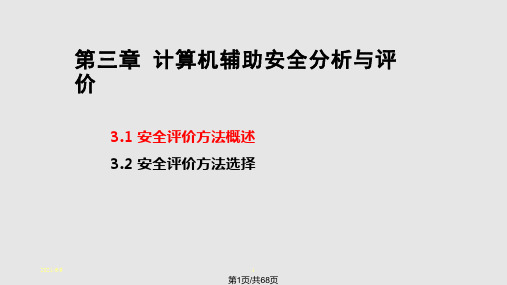
现象 硫酸 溢出
在线 分析 仪显 示出
…
原因事件 事故情况 结果
1. 地 坪 及 1. 地 坪 周 人 员 周边设备 围设备受 伤 害 不 防 腐 ; 腐蚀; 2.人 及 财 2. 现 场 人 可 能 受 灼 产 损 员 无 个 体 伤 3. 可 能 失 防 护 设备 ; 引起火灾 3. 设 备 周 围有易燃 物
2021/6/9
7
第7页/共68页
3.1 安全评价方法概述
3、按安全评价要达到的目的分类
事故致因因素安全评价方法:是采用逻辑推理的方法, 由事故推论最基本危险、有害因素或由最基本危险、有害 因素推论事故的评价法。
危险性分级安全评价方法:是通过定性或定量分析给 出系统危险性的安全评价方法。
事故后果安全评价方法:可以直接给出定量的事故后 果,给出的事故后果可以是系统事故发生的概率、事故的 伤害(或破坏)范围、事故的损失或定量的系统危险性等。
简 明 易 懂 , 容 易 掌 握 。
2021/6/9
14
第14页/共68页
2021/6/9
3.1 安全评价方法概述
❖ 安全检查表举例(气柜安全评价检查表)
序号
评价内容标准
评价标准
应得分 实得分
1 气柜各节及柜顶无泄漏。
一处泄漏扣 2 分
10
2
各节水封槽保持满水,水槽保持 少量溢流水。
一节不符合扣 5 分
一个不准确不得
15 分
20
第15页/共68页
3.1 安全评价方法概述
※ 安全检查表举例(顶板安全管理水平检查表)
考评类目
考评标准
考评办法
考评结果
顶板风险单元风险 辨识(20分)
LEC评估法与SEP评估法在矿山的实际运用及其优缺点
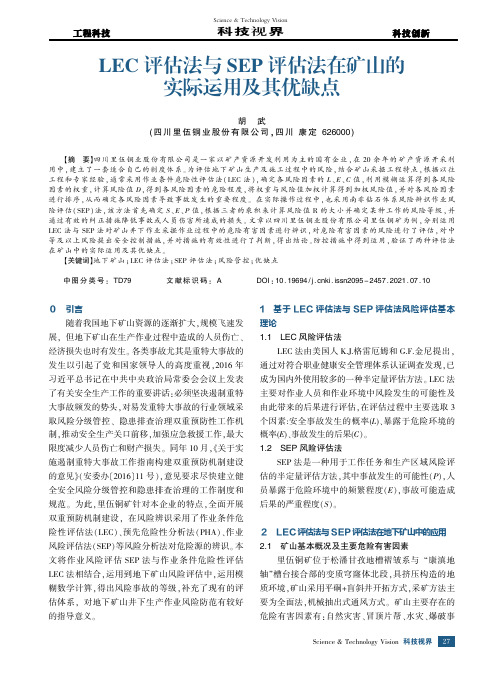
0引言,,、。
,2016:,、,,,。
10,《》(〔2016〕11),。
,,,(LEC)、(PHA)、(SEP)。
SEPLEC,,,,,。
1基于LEC评估法与SEP评估法风险评估基本理论1.1LEC风险评估法LEC K.J.G.F.,,。
LEC,3 :(L)、(E)、(C)。
1.2SEP风险评估法SEP,(P),(E),(S)。
2LEC评估法与SEP评估法在地下矿山中的应用2.1矿山基本概况及主要危险有害因素“”,,+,,。
:、、、LEC评估法与SEP评估法在矿山的实际运用及其优缺点胡武(四川里伍铜业股份有限公司,四川康定626000)【摘要】四川里伍铜业股份有限公司是一家以矿产资源开发利用为主的国有企业,在20余年的矿产资源开采利用中,建立了一套适合自己的制度体系。
为评估地下矿山生产及施工过程中的风险,结合矿山采掘工程特点,根据以往工程和专家经验,通常采用作业条件危险性评估法(LEC法),确定各风险因素的L、E、C值,利用模糊运算得到各风险因素的权重,计算风险值D,得到各风险因素的危险程度,将权重与风险值加权计算得到加权风险值,并对各风险因素进行排序,从而确定各风险因素导致事故发生的重要程度。
在实际操作过程中,也采用南非钻石体系风险辨识作业风险评估(SEP)法,该方法首先确定S、E、P值,根据三者的乘积来计算风险值R的大小并确定某种工作的风险等级,并通过有效的纠正措施降低事故或人员伤害所造成的损失。
文章以四川里伍铜业股份有限公司里伍铜矿为例,分别运用LEC法与SEP法对矿山井下作业采掘作业过程中的危险有害因素进行辨识,对危险有害因素的风险进行了评估,对中等及以上风险提出安全控制措施,并对措施的有效性进行了判断,得出结论。
防控措施中得到运用,验证了两种评估法在矿山中的实际运用及其优缺点。
【关键词】地下矿山;LEC评估法;SEP评估法;风险管控;优缺点中图分类号:TD79文献标识码:A DOI:10.19694/ki.issn2095-2457.2021.07.1027Science&Technology Vision科技视界、、、、、、、、、20。
简述lec评价法
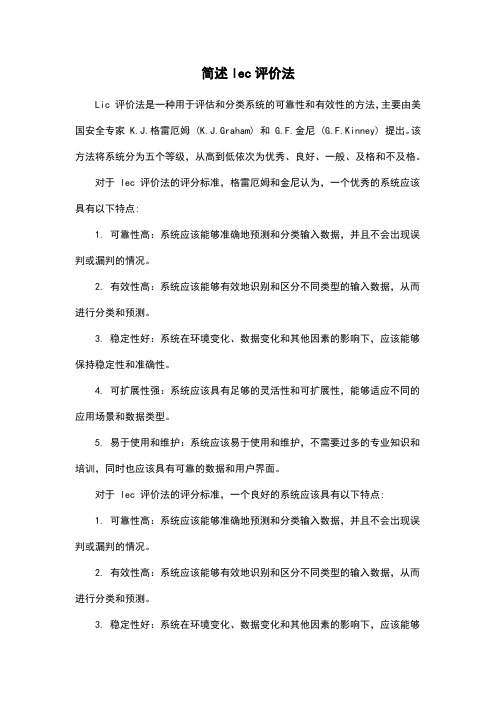
简述lec评价法Lic 评价法是一种用于评估和分类系统的可靠性和有效性的方法,主要由美国安全专家 K.J.格雷厄姆 (K.J.Graham) 和 G.F.金尼 (G.F.Kinney) 提出。
该方法将系统分为五个等级,从高到低依次为优秀、良好、一般、及格和不及格。
对于 lec 评价法的评分标准,格雷厄姆和金尼认为,一个优秀的系统应该具有以下特点:1. 可靠性高:系统应该能够准确地预测和分类输入数据,并且不会出现误判或漏判的情况。
2. 有效性高:系统应该能够有效地识别和区分不同类型的输入数据,从而进行分类和预测。
3. 稳定性好:系统在环境变化、数据变化和其他因素的影响下,应该能够保持稳定性和准确性。
4. 可扩展性强:系统应该具有足够的灵活性和可扩展性,能够适应不同的应用场景和数据类型。
5. 易于使用和维护:系统应该易于使用和维护,不需要过多的专业知识和培训,同时也应该具有可靠的数据和用户界面。
对于 lec 评价法的评分标准,一个良好的系统应该具有以下特点:1. 可靠性高:系统应该能够准确地预测和分类输入数据,并且不会出现误判或漏判的情况。
2. 有效性高:系统应该能够有效地识别和区分不同类型的输入数据,从而进行分类和预测。
3. 稳定性好:系统在环境变化、数据变化和其他因素的影响下,应该能够保持稳定性和准确性。
4. 可扩展性强:系统应该具有足够的灵活性和可扩展性,能够适应不同的应用场景和数据类型。
5. 易于使用和维护:系统应该易于使用和维护,不需要过多的专业知识和培训,同时也应该具有可靠的数据和用户界面。
对于 lec 评价法的评分标准,一个糟糕的系统应该具有以下特点:1. 可靠性低:系统会出现大量的误判或漏判,导致系统的有效性和稳定性下降。
2. 有效性低:系统无法准确地识别和区分不同类型的输入数据,导致分类和预测结果不准确。
3. 稳定性差:系统在环境变化、数据变化和其他因素的影响下,准确性和稳定性下降。
lec判别法
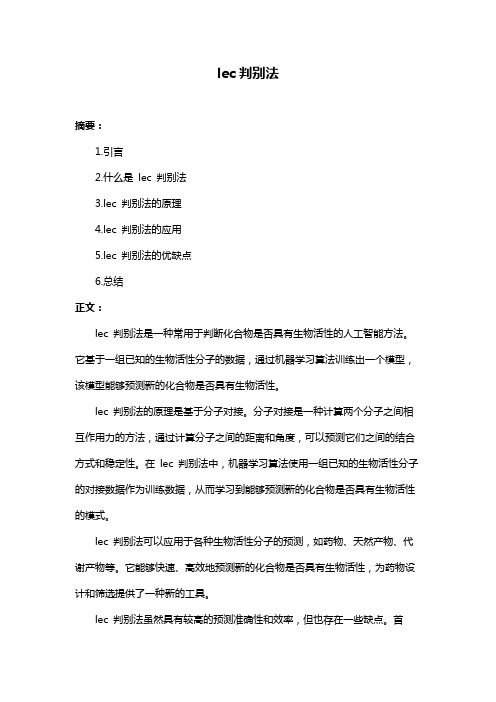
lec判别法
摘要:
1.引言
2.什么是lec 判别法
3.lec 判别法的原理
4.lec 判别法的应用
5.lec 判别法的优缺点
6.总结
正文:
lec 判别法是一种常用于判断化合物是否具有生物活性的人工智能方法。
它基于一组已知的生物活性分子的数据,通过机器学习算法训练出一个模型,该模型能够预测新的化合物是否具有生物活性。
lec 判别法的原理是基于分子对接。
分子对接是一种计算两个分子之间相互作用力的方法,通过计算分子之间的距离和角度,可以预测它们之间的结合方式和稳定性。
在lec 判别法中,机器学习算法使用一组已知的生物活性分子的对接数据作为训练数据,从而学习到能够预测新的化合物是否具有生物活性的模式。
lec 判别法可以应用于各种生物活性分子的预测,如药物、天然产物、代谢产物等。
它能够快速、高效地预测新的化合物是否具有生物活性,为药物设计和筛选提供了一种新的工具。
lec 判别法虽然具有较高的预测准确性和效率,但也存在一些缺点。
首
先,它依赖于已知的生物活性分子的数据,如果数据集不够全面或者不够准确,预测结果也会受到影响。
其次,lec 判别法只能预测分子是否具有生物活性,而无法预测分子的生物活性强度和作用机制。
综上所述,lec 判别法是一种有效的工具,能够快速、高效地预测新的化合物是否具有生物活性。
LEC评价法

LEC评论法LEC评论法是对拥有潜伏危险性作业环境中的危险源进行半定量的安全评论方法。
该方法采纳与系统风险率有关的 3 种方面指标值之积来评论系统中人员伤亡风险大小。
这 3 种方面分别是: L 为发惹祸故的可能性大小; E 为人体裸露在这类危险环境中的屡次程度; C 为一旦发惹祸故会造成的损失结果。
风险分值 D=LEC。
D 值越大,说明该系统危险性大,需要增添安全举措,或改变发惹祸故的可能性,或减少人体裸露于危险环境中的屡次程度,或减少事故损失,直至调整到同意范围内。
对这 3 种方面分别进行客观的科学计算,获得正确的数据,是相当繁琐的过程。
为了简化评论过程,采纳半定量计值法。
即依据过去的经验和预计,分别对这 3 方面区分不一样的等级,并赋值。
详细以下:事故发生的可能性( L)分数值事故发生的可能性10完整能够料想6相当可能3可能,但不常常1可能性小,完整不测0.5很不行能,能够假想0.2极不行能0.1实质不行能裸露于危险环境的屡次程度(E)分数值裸露于危险环境的屡次程度10连续裸露6每日工作时间内裸露3每周一次或有时裸露2每个月一次裸露1每年几次裸露0.5特别稀有裸露发惹祸故产生的结果(C)分数值发惹祸故产生的结果10010 人以上死亡403~ 9 人死亡151~ 2 人死亡7严重3重要,伤残1引人注意风险剖析依据公式:风险 D=LEC就能够计算作业的危险程度,并判断评论危险性的大小。
此中的重点仍是怎样确立各个分值,以及对乘积值的剖析、评论和利用。
D 值危险程度>320极其危险,不可以持续作业160-320高度危险,要立刻整顿70-160明显危险,需要整顿20-70一般危险,需要注意<20稍有危险,能够接受依据经验,总分在 20 以下是被以为低危险的,这样的危险比日常生活中骑自行车去上班还要安全些;假如危险分值抵达 70~160之间,那就有明显的危险性,需要实时整顿;假如危险分值在160~320 之间,那么这是一种一定立刻采纳举措进行整顿的高度危险环境;分值在 320 以上的高分值表示环境特别危险,应立刻停止生产直到环境获得改良为止。
